Don't wanna be here? Send us removal request.
Text
My YouTube History
I started off on YouTube the same way a lot of people spend their whole existances: with a channel made for the purpose of subscribing to people and having a favorites list, and having few subscribers and no videos. My first channel was called Espmasterrr, and I made it I think in March 2009. It had this odd title because this was back when YouTube forced you to choose unique username, and "Espmaster," my regular name, was taken by someone who never used their channel. Anyways, I spent most of my time on YouTube with the Sonic fandom. In hindsight, I can't technically call the people I met there "friends," but I talked to people such as Sonamy789 and her younger sister on occasion, and learned a lot about channel design. (It was also around this time that the Beta channels were implemented.) Through social connections, I somehow managed to amass almost 50 subscribers before I even started making videos. There were two common naming trends that went around the group I hung out with: Starting and following a username with Xs, and the title scheme ILove(Insert Chracter Here)1234, which I believe was started by Sonamy789's sister. Thus, I used to have a channel named ILoveEevee1234, which just kind of... existed there. One day, I got hacked by some jerk who was friends with another jerk named ElRealMario64, so I briefly made an account called PrinceFlareon because I managed to get back into my ILoveEevee account. Luckily, the person who hacked me wasn't really trying to do anything other than frighten me, so they didn't even bother to change the e-mail. So I managed to get access to my Espmasterrr account. I deleted PrinceFlareon and continued business as usual. I started uploading videos, the first two of which were called My Reaction to Cookie Monster Stars in a Spaghetti Western and Duke the Dog in the Backyard. Most of my videos in the Espmasterrr era involved either me watching YouTube videos on my iPod Touch with my camera held up next to it, or me and Drake doing random funny stuff. A snippet of the era survives through my old "Sleepover" videos and the "Cookie Conquest" series, both of which made it to my XEspmasterX channel as re-uploads. I know that at least The Sleepover I and II were on Espmasterrr originally, possibly III as well. I also made another channel called TheBreonKing which served as my official alt, a channel called PrinceFlareon2 which I used to make playlists because the playlists on my Espmasterrr channel were cluttered, a channel with the letter w followed by a bunch of random numbers which housed my very first let's play, and a channel called StupidBlasterCJ which was named after my neighbor CJ's complete butchering of my username. In early 2010, I apparently got tired of having 80 different channels and deleted all of them, and made a new channel using the OTHER naming cliché of the day, and my new standard username, XEspmasterX, was born. Even this era was initially plagued with unnecessary extra channels, At one point, I re-opened ILoveEevee1234 again, and then closed it again. I tried to reboot my StupidBlasterCJ channel with a channel called just StupidBlaster, but I lost interest shortly in. I also had a channel called PrinceFlareon3 which was used to archive the videos of YouTubers than had been banned, but this channel eventually went the same way as the other 2. Eventually, summer of that year, I began my original Hot Wheels Velocity X let's play. I hadn't been happy with my previous two attempts at Let's Plays, which were of Star Wars Battlefront II and Sly Cooper. So I wanted to do a clean reboot with a game that actually didn't have another guide anywhere on the internet at the time, thus establishing a niche for my channel. It worked. Thus ends what I call the first era of my time on YouTube. From then on, my YouTube experience was centered around Let's Play. I followed up Hot Wheels Velocity X with yet another game which didn't have a single walkthrough (and I think still doesn't have another one,) Gadget Racers. After establishing a surprisingly strong audience for Hot Wheels and ChoroQ videos, I continued doing more games in these series while also doing other games I just enjoy (such as the Sly Cooper series.) In 2015, I got a capture card, allowed me to greatly improve the quality of my videos. I also started becoming heavily involved in making collab projects with my best friends, such as Da12hKind (now Doorman Net Productions,) TheSteveEngine, Kingguyred and Anmica364. These events begin my current and third era, in which I make videos of games I like and am constantly trying to improve my content. So, that's how I got to where I am today, now with over 400 subscribers.
0 notes
Text
On the meaning of The Lamb Lies Down on Broadway, Peter Gabriel's journey into enlightenment, the magic in Genesis, and all the rest.
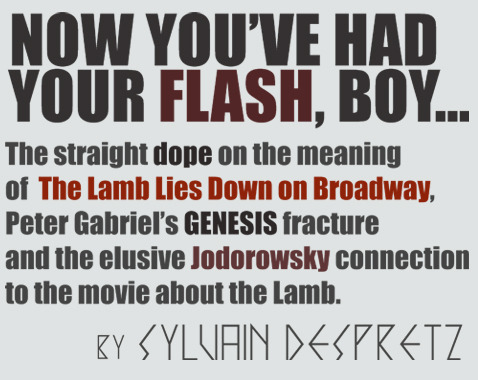
I was casually browsing our beloved Web, sourcing tidbits of data about the 1974 double album The Lamb Lies Down on Broadway by the Rock group Genesis, when I came upon one too many fuzzy, (albeit well-intentioned) attempts on the part of some eager fan to explain to the rest of the World the meaning of the now legendary Rock record that eventually drove its writer, Peter Gabriel, to split from the group he had led into international fame…
It occurred to me that I may be in a unique position to offer insights into a part of the behind the scenes thanks to my own experiences which brought me close to some of the highest authorities on the matter–for one, Chilean showman, self-described metaphysician, and all around late-night guru of French TV Metaphysics, Alejandro Jodorowsky, whom I became personally acquainted with for over twenty years, and who was once himself tapped by Peter Gabriel to direct a movie project based on the eponymous Rock Opera.
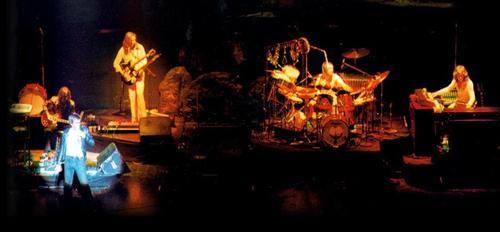
Peter Gabriel has been known to have described Alejandro Jodorowsky as “the only person who could direct a movie based on The Lamb” because he had made the 1971 cult oddity El Topo, which topically portrayed a very personal vision of the fracture and ensuing darkness known as the ego death, with its rebirth into the one-mind, following a sudden flash of ‘enlightenment’.
When I pestered him sufficiently, Jodorowsky gave me a copy of The Lamb Lies Down on Broadway’s English language film script which he and Peter Gabriel co-wrote at Gabriel’s home in Bath, UK, over a 3 week period in 1979. “El Cordero de Broadway” is scribbled in Spanish onto the cover in ballpoint pen. I still have it on my shelf–a rare artifact. The script which is only 49 pages long (about half the length of a normal film script) contains little dialog, and details a story told in images and music that underscores the spiritual experience hinted at in the Genesis album’s lyrics and liner notes. (Jodorowsky later called the joint effort “an extended music video,” inaccurately adding “before music videos were invented.”)
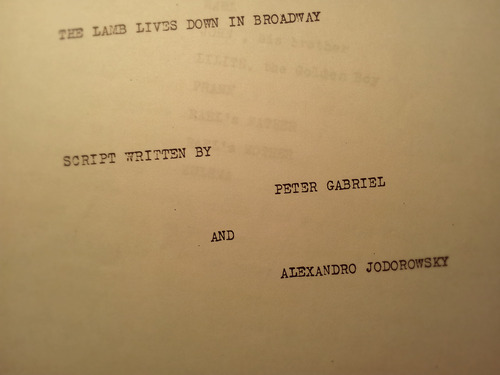
Quite apart from my own interest in The Lamb Lies Down on Broadway, or my incidental meeting with Peter Gabriel many years ago in New York City, there are peripheral connections patching me into this very topic, which need not necessarily be mentioned here and now, but which allow me to say with some confidence that I can contribute my two cents, at least to the satisfaction of a few readers who require a straight answer.
So, as a fan of the album for almost as long as it has existed, with all the time I have had to think about it, and about conversations or statements made by participants, and most of all by reflecting on my own life’s experience, I would like to say out loud and in fairly tight prose what, in my view, The Lamb Lies Down on Broadway is really about, why Peter Gabriel wrote it, and why he must have felt he had nowhere to go with Genesis afterwards. This, of course, in the spirit of contributing to the pool of human ideas about why things appear as they do–
Peter Gabriel had a flash of “enlightenment” in the early Seventies–a real one that is, and not your lite, stoner brand of “yeah, I get it; we’re all One–reality, what a concept”… No; he got the real deal; that’s the short end of it.
His burst of illumination blew his mind wide open to the very nature of what Eastern mystics (and deeply religious scholars in the Christian Gnostic tradition, to mention only a few,) often refer to as the experience of spiritual grace, or “realization” or yet again “understanding”. More ancient traditions have sometimes referred to it as a “Eureka moment” though the term has often been bastardized to point to more mundane flashes of understanding than what we are presently discussing.
(“Now you’ve had your flash, boy.”)

There are many other names for it, of course, but regrettably, those names are often prescribed as put-downs by people who have little understanding of the state of mind involved. Equally, it is difficult to use limited words to talk about going beyond limits… Further still, the common consumer language of anything ranging from Rock & Roll to movies and TV, or Internet blogging, is poorly designed to transport messages that amount to pulling the rug from under the whole of our reality, and The Lamb Lies Down on Broadway deals with a sort of personal Apocalypse: the end of the World as we know it, or as Peter Gabriel knew it, anyway…
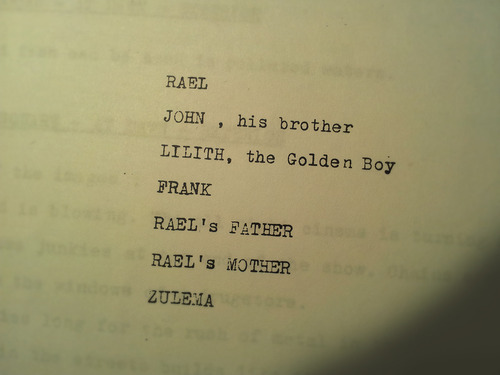
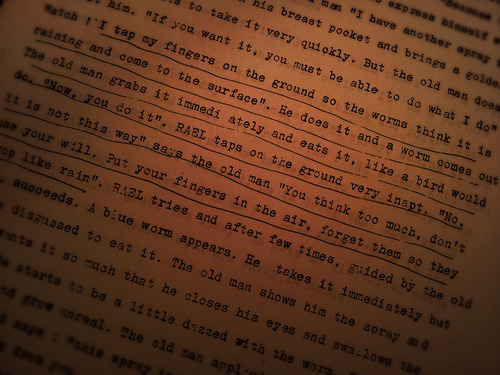
Why did I call it 'the real deal’, and as opposed to what? The level of experience Peter Gabriel refers to in The Lamb Lies Down on Broadway isn’t a simple matter of the protestant ritual of being “born again”, or the foggier “finding Jesus”, which for our purpose would require infinitely more background, and would lead to other digressions away from our present subject, but it does refer instead to something altogether more potent, explosive, and uncharted.
The truth of any experience we have and cherish is always there for any of us to reassess, but one thing is certain: society is eager to process and commoditize all our aspirations and sensations, and loves to keep our panic attacks down to a minimum. (William Burroughs famously defined a psychotic as “someone who’s just figured out what ’s really going on”!) Beyond the tall walls that keep our village safe from the wilderness of the mind is where we find the wandering mystics or better yet, find the opportunity to become one ourself. Out there, we may run into the likes of Peter Gabriel and The Lamb Lies Down on Broadway.
This spiritual 'event-horizon’ is of course both common and rare in humanity; it is documented, if not always well (admittedly, it was more common in our culture during the psychedelic '60s,) which makes it very difficult to talk about because most people revile the mention of human experiences to which they are not privy: their response is often one of contempt, harsh criticism, mockery or cynical rejection, and Peter Gabriel felt he had to transpose his beatific vision into the form of an artful urban nightmare painted upon the landscape of New York City as its canvas. Presumably Manhattan was a location of some significance to his breakthrough. Or perhaps, eager to impart a pressing humanist revelation, he chose a modern decaying metropolis to break out of the constellation of mythical creatures and madrigal pantomimes previously associated with Genesis; their comfort and expectations shattered, Peter Gabriel has regained the full attention of his fans.
He conceived of The Lamb Lies Down on Broadway in a state of deep confusion and turmoil, as he felt his own world coming apart: one of the terribly distressing features of this real enlightenment business, which Gabriel clearly identified, is that things aren’t all rosy and blissful, and they can turn into a non-chemically induced bummer on a dime, and stay there as the universe of matter and duality falls away… Gabriel writes of the sense that the World is fracturing around him, resulting in a sort of profound death of the self, a propulsion into chaos. Only after a time spent in darkness and confusion, can he emerge, embracing the realization that all is one, there is no “other”, and that personal identity is an illusion of the ego. The world is revealed as the cosmic dream of the self–no longer real in the sense we once thought of it. Or real at all, for that matter…
And “does Earth plug a hole in Heaven or Heaven plug a hole in Earth?” Anyone?
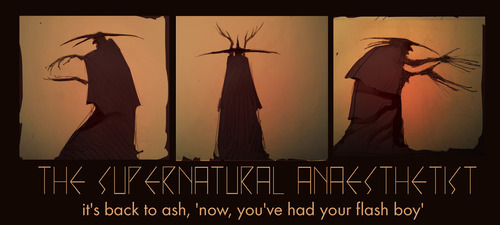
“It’s good to feel you’re you again. It’s been a long, long time; hasn’t it?”
In a way, the first hint of a spiritual breakthrough appears the song “Supper’s Ready” from the album Foxtrot, a couple of years prior, as Peter Gabriel describes looking into the eyes of the woman he loves, returning to her at last, after wandering lost in the depths of inner-space. But what led to The Lamb Lies Down on Broadway seems more significant, somehow–more concrete. Or perhaps more organized into a narrative mythology one can take on the road. Certainly, for Peter Gabriel, The Lamb became his opportunity to commit all of it to a single, self-contained work of art.
Peter Gabriel felt he had to speak-out in the form of a fictional, poetic, dream-like stories, for no reason other than, still tethered to his public persona and his duty to perform, he didn’t want to appear to have gone mad, a frequent occurrence when people go through this blast of deep consciousness… And this was especially important because he felt he had to convince other members of the Rock group Genesis to let him control the entire 'Lamb’ album, even though for the most part, they did not seem to understand his mission. Other members, with the possible exception of guitarist Steve Hackett, seemed to all be busy wondering how they could turn those songs into singles so they could score in the charts, and to this day seem to deplore the fact that the album remains opaque. (Hackett later followed Peter Gabriel out the door, freeing the remaining members of Genesis to scale the slippery facade of Billboard’s Top 40.)
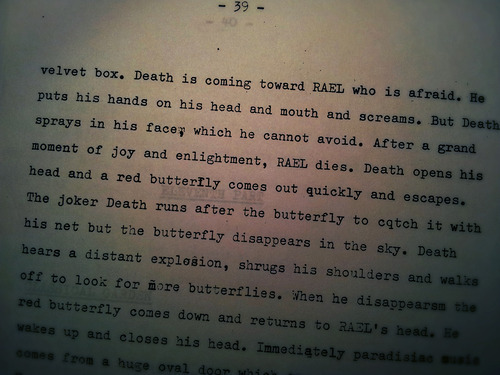
Peter Gabriel penned this story of a young man which he named Raphael, or “Rael”, presumably because the archangel Raphael refers to “God who heals” or simply because it is the acronym of “real” and the story deals with the stripping away of reality. Another reason may be that Raphael is almost homophone to Gabriel and he clearly transposed himself into the tale, as he was equally prepared, for a time, to play Rael onscreen, had he and Jodorowsky been successful.
Some people make the mistake of trying to interpret every minute aspect of Rael’s colorful adventure, or every metaphor in Supper’s Ready; they transcribe the songs into intelligible mental narrative, extracting precise meaning from all the theatrical images, which of course do resonate with themes that were important to Peter Gabriel. But his writing, like that of Alejandro Jodorowsky in the later contributions to the film project, is freely associative, and taps into the unconscious, and therefore must be seen as more instinctive than literal–who in their right mind would try to explain a poem? People who do are not wrong in the things they point out, but they can easily miss the forest for the trees–or get sucked into writing entire, often pompous (as this piece is teetering on the verge of being) doctorate theses on the matter, or drift into bean-counting and irrelevancy, and this can distract from the essential mojo of The Lamb Lies Down on Broadway. The cold, scholarly description of this type of experience remains frozen in mental concepts, but Peter Gabriel was writing about his amazement over the experience of his breakthrough–one that is infinitely more elusive than all the vernacular used by scholars of philosophy to muse about it.
I will not go into trying to interpret every shred of symbolism in the album because it has already been done and can be found online in a number of forums; my interest here is in highlighting the part that actually mattered most to Peter Gabriel–the one that eventually split him up from the rest of the group because they couldn’t follow… This is also why it was so hard for Peter Gabriel to agree to let his band mates share in the writing of The Lamb Lies Down on Broadway, and why he knew that he never would again be able to allow anyone to meddle with his lyrics. He felt a precious sense of heightened awareness of his own spirituality, and, despite it being the '70s, a time when a lot of people tripped-out on LSD and other temporary empathetic highs, he felt he could not comfortably share his state of mind with his peers to a satisfactory extent, hence his departure, which he has amply discussed since in roundabout ways, often using various metaphors, presumably to avoid offending other members of Genesis, or to avoid seeming too pretentious in the eyes of the Press. It can safely be said about Peter Gabriel that he can beat around the bush at times, he is not terribly loquacious, and he certainly is not literal about “shouting-out what he has found…” Instead, he buried his truth deep under layers of imaginative storytelling and sang out-loud what he’d found; in 1974, just as film maker William Friedkin began courting him for his seminal concepts, Peter Gabriel was practicing his own personal exorcism of sorts through fathering The Lamb Lies Down on Broadway…
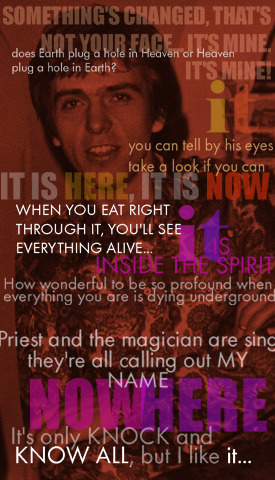
The Lamb Lies Down on Broadway’s message is hidden in cryptic language–perhaps too cryptic to be effective–one can argue, but clearly, this was too big and too powerful for him to simply write it out in plain English, and surely, the message would not have been very well received if it had been too didactic.
Anyway… That’s what the Lamb is fundamentally about; it was a message in a bottle from Peter Gabriel, cast adrift to anybody out there who understood what he had just gone through, and his departure from Genesis was a mark of his distress over the fact that his band mates had no fucking idea what he was experiencing: he was drifting away from the material World. Of course, there were many more reasons that caused structural pressures for Genesis, and other Rock groups, and just about anything creative at the end of the '70s, but for the purposes of this topic, I choose to focus on this very specific dislocating agent: The breakthrough.
But it is interesting to note that the period of most consensus on Genesis–the Peter Gabriel years–possesses a sort of “magic” which seems hard to define until one realizes what Peter Gabriel was mostly writing about. Genesis in those days created music that truly affected the spirit of the listener; and for good reasons!

Peter Gabriel began to think that he had to radically transform all of his life after the Lamb, and did so, in some ways, but like everyone who goes through this sort of experience, ended up returning to the world of the mundane to share in its busy-ness and to rejoin the human race, which in the end is Alpha and Omega to us all…
I recommend studying closely the lyrics of his 1977 songs “Here Comes the Flood” (which he planned on including in the Lamb movie,) and “Solsbury Hill” for further elaboration on his crisis and the way he dealt with it.
I want to stress that I think people are correct, of course, when they write about to the many religious, shamanic, and metaphorical symbols in the song Supper’s Ready and in the album The Lamb Lies Down on Broadway, but what is most important in understanding the album is that Peter is Rael, the message is not about some gratuitous fictional and abstract third party concept, but about a direct experience, and the trip he was on was urgent, and life changing–one of sudden ego collapse, and descent into the darkness, with a realization at the end of the tunnel.
***
For the lazy man’s highlights of the relevant The Lamb Lies Down on Broadway exhibits, see the following key lyrics, among others:
“The priest, and the magician are singing all the chants that they have ever heard and they are all calling out my name, even academics, searching printed words…”
“Does Earth plug a hole in Heaven, or Heaven plug a hole in Earth?”
“I could have been exploding in space Different orbits for my bones Not me, just quietly buried in stones, Keep the deadline open with my maker!”
“Is this the way out from the endless scene? Or just an entrance to another dream?”
“Somethings changed, that’s not your face. It’s mine - it’s mine!”
“it is the jigsaw. it is purple haze. it never stays in one place, but it’s not a passing phase, it is in the singles bar, in the distance of the face it is in between the cages, it is always inner space.”
“When you can eat right thru it you’ll see everything alive it is inside the spirit with enough grit to survive […] look across the mirror sonny before you choose, decide.”
“it is here, it is now” (Here and Now are common concepts in spiritual language, also echoed by Gabriel in the video Shock the Monkey HERE, NOW = NOWHERE)
And:
“'cos it’s only knock and know all, but I like it…”
Last but not least, from Peter Gabriel’s own album liner notes: “Rael cannot look away from those eyes, mesmerized by his own image. In a quick movement, his consciousness darts from one face to the other, then back again, until his presence is no longer solidly contained in one or the other. In this fluid state he observes both bodies outlined in yellow and the surrounding scenery melting into a purple haze. With a sudden rush of energy up both spinal columns, their bodies, as well, finally dissolve into the haze. […] All this takes place without a single sunset, without a single bell ringing and without a single blossom falling from the sky. Yet it fills everything with it s mysterious intoxicating presence. It ’s over to you.”
Cryptic, sure, but also very clear and deeply personal for Peter Gabriel, and as I said, very difficult to this day for him to really talk about since only relatively small clusters of people are ultimately in on “it.”
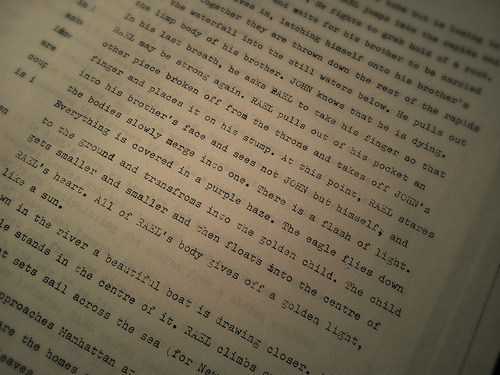
As a post-script, I should say that the relationship between Peter Gabriel and Alejandro Jodorowsky did not bear many fruits, save for an occasional Tarot card reading which Jodorowsky agreed to do for Peter in subsequent years, often over the phone, to address some question of emotional distress over little more than a broken heart. There are many reasons for the failure of the film project to take off as well, (including lack of financing enthusiasm) but knowing the characters involved, it is safe to say that egos as well as differing spiritual paradigms got in the way of a successful collaboration. Jodorowsky later admitted to me that he had never actually taken the time to listen to the whole album, and hadn’t really wanted to follow all of Peter Gabriel’s ideas, which were his own personal metaphors - as a for instance: the resolution of the story’s “Lamia” episode, which led to a strong disagreement between the two as Jodorowsky did not want for Rael to eat the remainder of the Lamia’s bodies, but rather believed that the half-snake half-women should eat him, because in Jodorowsky’s spiritual language, the Cabalistic symbol possessed a different meaning; one he preferred, etc… There were many more disparities in their respective understanding of symbols. The whole thing deflated softy until it was forgotten.
Further, music was never really Jodorowsky’s cup of tea and he had no grasp of the Art-Rock culture or real appreciation for the musical palette involved; he hated the sound of piano, and claimed to have only listened to one single album, the only one he ever owned, in endless loops for many years: “Renaissance of the Celtic Harp” by Alan Stivell.
Years later, I took the 83 year old Jodorowsky to see The Musical Box perform the full The Lamb Lies Down on Broadway, which he had never seen onstage, and at the end of the show, the old man nodded and simply said “Now I can finally see what the guy was going on about!”–presumably an admission which Peter Gabriel himself never got to hear, to this very day.
So it goes…
Written account, and “Death” triptych illustration, ©2013, by Sylvain Despretz.
Photo of Genesis performing The Lamb ©1975, by Armando Gallo – all concepts and lyrics are of course the property of Peter Gabriel, Genesis, and Hit & Run Music Ltd.

97 notes
·
View notes
Text
Gadget Racers and the Choro Q HG Series
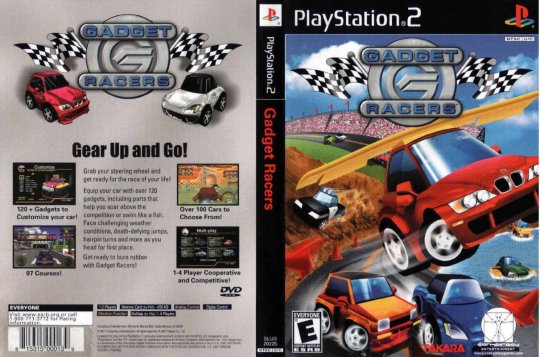
This is the North America box art for Gadget Racers for PS2, known in Japan as Choro Q HG 1 and in Europe as Penny Racers. It was probably the 6th or 7th game I ever owned. I got it after my mom broke my copy of Hot Wheels Velocity X (long story) and when she got a new one she also picked this game up to make up for breaking it. This is when I was like 6. It's relatively obscure, but there is a strong cult fandom for the Choro Q series on YouTube, which I drew to myself when I did a walkthrough of Gadget Racers back in like 7th and 8th grade. I did it because I couldn't find a single other walkthrough for it on the internet, and as I was new I wanted to start off with a niche. This ended up working well for me, actually.I currently have over 400 subs and most were drawn from my Gadget Racers and (ongoing) ChoroQ walkthroughs or my Hot Wheels videos.
Gadget Racers is a very simple racing game in which you fully customize a car and race for money. It's surprisingly fun, but the controls can take some getting used to, which is why when I did a separate series covering multiplayer, @hypernovatic hated the game.
Right now, it is sitting at #24 on my favorite games list. IGN gave it a 6/10.
After my Gadget Racers walkthrough took off, I tracked down two of its sequels, Choro Q HG 2/Road Trip, and Choro Q HG 4/Choro Q. I also did a video explaining the place of Gadget Racers within the series years back. I started a blind Let's Play of Choro Q (Choro Q HG 4) in like 2012, and it is still ongoing due to numerous hiatuses.The most recent of which being my broken PS2 and band camp/freshman orientation.I have come to like the game a lot, though, so I plan on finishing it even if it's taking forever. I currently have 30 episodes of ChoroQ. Pretty slow progress. After I revived the series from a roughly 2 year long hiatus my junior year after I got a capture card, I received a slew of really helpful advice from the owner of the official Choro Q wiki (Luna Hydreigon).
The games will likely be very hard to track down. When I found Choro Q HG 2 and 4, it was like 2012, before the PS4 was a thing. Amazon is your best bet. A brief overview:
Choro Q HG 1 (JP)/Gadget Racers (NA)/Penny Racers (EU) is the simplest that I’ve played, being purely menu based and not having an actual plot. The game centers around racing for money, buying parts and using the parts to win more races. It’s more addictive than it sounds. I recommend turning down the sound effects volume.
Choro Q HG 2 (JP)/Road Trip (NA)/Road Trip Adventure (EU) is the most complicated that I’ve played, though I’ve only played it once as I decided to LP HG 4 first. It has a huge hub world that contains tons of sidequests, and a very simple plot.
Choro Q HG 3 (JP)/Gadget Racers (EU) I don’t really know anything about. I think there’s a playthough on YouTube, but I haven’t gotten around to watching it. It goes for $0.01 on Amazon, but the PS2 is region-locked.
Choro Q HG 4 (JP)/Choro Q (NA/EU) is somewhere in the middle between HG 1 and HG 2. It has a hub world, but a manageable small one, though it also has a pretty complex and involved plot, and a ton of integrated sidequests. It is probably the most “serious” in tone of the games that I’ve played.
#Gadget Racers#racing#Playstation 2#XEspmasterX#Penny Racers#Choro Q#ChoroQ#Choro Q HG#youTube#Let's Plays#Road Trip#Japan
1 note
·
View note